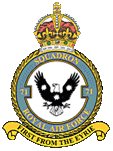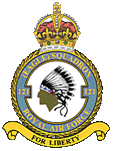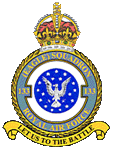The Eagle Squadrons



Their Inception
As World War II engulfed Europe in the fall of 1939, many Americans volunteered for service abroad. From April 1940 through early 1942, tens of thousands of Americans flew for the Royal Canadian Air Force (RCAF) and the British Royal Air Force (RAF).
Among those thousands were the Eagles. The Eagles came from all over the United States. These men volunteered for numerous reasons, some for altruism and others for adventure. In the course of two years, 244 Americans flew as Eagles, forming three Eagle Squadrons: the 71st, 121st, and 133rd. Operational in the RAF from 1940-1942, collectively the Eagles are credited with the destruction of 74 German aircraft.
The brainchild of a prominent and affluent American businessman living in England, named Charles Sweeney, the Eagle Squadron's original and sole intention was to be used as a tool of propaganda. From print to film, the Eagles were used to sensationalize, invigorate, and mobilize the U.S. towards war.
To this day, the Eagles conjure up images of courage, skill and fortitude. They are known to many as men who gallantly fought for the preservation of Britain and democracy as they waited for their own nation to enter into the conflict.
The Eagles were among the first Americans to face the horrors of the war. They made crucial contributions to a nation teetering on the edge of destruction, for which they are permanently imbedded in the English consciousness.
The Recruitment Process
In April of 1940, a vital transfusion of pilots from the U.S. began. Before the outbreak of the war, the Royal Air Force (RAF) had hedged its bets by implementing the RAF expansion programs to meet Germany's challenge. In 1936, the Air Ministry began exploring the training of reserve officers throughout the British Commonwealth.
For this task, the Empire Air Training Scheme was implemented. Investigating dozens of possible countries for operations: Canada, Australia, New Zealand, South Africa, and Rhodesia were chosen for the training of thousands of RAF crewmen. Although the scheme was not fully implemented until the outbreak of the war, in the four years that these training schools existed they turned out over 236,000 foreign born pilots.
In 1940, the Empire Air Training Scheme was expanded to include the United States. The RAF and the Royal Canadian Air Force (RCAF) were well prepared for an expansion of the program. Prior to the start of the war, the RCAF Vice Marshall Billy Bishop had approached Clayton Knight, an American who had flown for the Royal Flying Corps in World War I, to recruit pilots from the U.S.
In April of 1940, the Clayton Knight Committee went into action. Knight went to work quickly setting up "interview centers" in New York, Los Angles, Dallas, Kansas City, Chicago, Memphis, Cleveland, St. Louis, Oakland, and San Antonio. Despite a clear violation of the Neutrality Acts, which mandated a $1,000 fine for those who volunteered to fight for foreign militaries, recruitment proceeded relatively smoothly. The Knight committee was able to move so freely because of tacit approval given by president Franklin Delano Roosevelt, who had strong pro-British leanings. When confronted about his recruiting, Knight declared "We definitely are not recruiting.We merely are interviewing candidates, giving them physicals and flight tests, and then recommending them to the Canadian authorities."
Between April 1940 and December 1941, the Knight Committee handled 50,000 applications and cleared 6,700 pilots for service in the CRAF and RAF. In June of 1940, Charles Sweeney proposed in a letter to the British Air Ministry the establishment of an "American Air Defense Corps." Sweeney had taken the idea for an American squadron from the WWI American volunteer French Lafayette Escadrille. This exclusively American squadron would be the 71st Squadron: the Eagle Squadron. By August of 1941, two additional Eagle Squadrons were in operation: the 121st and 133rd. In the course of the next year-and-a-half, 243 American pilots, sixteen British pilots, and twenty-eight special duty officers would fly as Eagles.
Sweeney personally recruited the first men of the Eagle Squadron on American soil, spending $40,000 of his own money and raising an addition $60,000 in contributions for the recruitment process. However, do to his blatant and open practices of seeking the spotlight, along with entertaining volunteers at "champagne parties," the British ministry recalled him, fearing the endangerment of the recruitment program. The British put all subsequent recruitment of Eagle pilots in the hands of the more subtle Knight Committee, which ultimately recruited 92% of the Eagles.
The trickle of American pilots into the RAF had begun. Britain's relief was forthcoming as 22,700 American pilots came to her assistance. Almost three hundred Eagles were among the very first pilots that propped up a depleted and badly ravaged RAF in 1940.
Taking to Flight
The initial skill level of a typical Eagle was less than adequate. While all applicants to the Knight Committee were required to have a minimum of 400 hours of flight time, very few actually did. Many, like Richard Alexander, had never even flown before they signed on.
Initially the Eagles were trained in England. The first three to sign-up, Vernon Keough, Eugene Tobin, and Andy Mamedoff, were given fifty dollars and a ticket across the Atlantic to France, where they were to train. The French, hard-pressed by the advancing Germans, had no interest in them. Finding themselves in danger of being captured by the Germans, they met up with three Czech pilots and attempted to steal an airplane to escape. Their plans were foiled and all three Czechs were mistaken for Germans and killed. Becoming part of the fleeing refugee masses, they managed to board one of the last ships going to England and escape just as France fell to Germany. Other Eagles followed by more practical ways to England for training.
Many Eagles were trained, with other volunteer pilots, in the United States at civilian schools. Under the euphemism of being trained as ferry pilots, the RAF out-maneuvered the Neutrality Laws. 3,000 candidates were trained annually. Three schools were chartered, the Spartan School of Aeronautics in Tulsa Oklahoma, the Dallas Aviation School in Dallas, and the Polaris Flight Academy in California. Training at these schools was rather pitiful, with pupils leaving with as little as three hours of flight time. From the RCAF came nearly twenty percent of all Eagle pilots.
Six months lapsed between the announcement of the 71st Eagle Squadrons conception and it being combat ready on October 8, 1940. The 121st and 133rd quickly followed. In May 1941 the 121st was fully operational, and by August of 1941 the 133rd was also fully operational. Throughout 1941 the squadrons were at various level of readiness, but by 1942 all three were actively in the fight against Germany.
The road ahead was a bumpy one. The first bump the 71st had to over come was a lack of aircraft. The second bump was the aircraft they received. In late October they were issued Brewster Buffalos. As Eagle Chesley Peterson put it, "Considered by all of us as too slow, ceiling limited, terribly vulnerable-one bullet in the wing and the aircraft either burned or needed a new wing." Soon enough they would receive the Hawker Hurricane and eventually the Spitfire.
The Eagles proved formidable adversaries for the Messerschmitt 109s and Focke-Wulf 190s that they faced. The Eagles fought hard and earned a respectable record. The first Eagle Squadron engagement ensued on July 2, 1941. While escorting Blenheim bombers over the continent, the 71st Squadron was engaged by 25 Messerschmitt 109s. The Eagles drew blood for the first time, shooting down three Messerschmitts. The 121st Squadron's first kill soon followed with the downing of a Junker 88 by Joe Durham and Fred Scudday. The 133rd Squadron's first kill came on February 5, 1942.
In the summer of 1942, all three Eagle Squadrons flew together for the first and only time in Operation Jubilee. During this operation over the continent, designed to test German strength, the Eagles performed with impressive skill. On August 19, the Eagles collectively destroyed thirteen German aircraft and damaged fourteen more with a cost of one kill and one prisoner of war to the Eagles. According to Philip Caine, "this was the highest scoring single day for the units and marked them each as among the most effective squadrons in fighter command."
In the course of eighteen months of operational flying in the RAF, the Eagles garnered 40 decorations and 73.5 kills: the 71st squadron being credited with the destruction of 41 enemy airplanes, the 121st with 18 kills, and the 133rd with 14.5 kills. This is the equivalent of 6 Luftwaffe squadrons being destroyed.
The Eagles did not set any records, although at times they did lead fighter command in kills and operational missions, still their tactical value was an integral part of the defense of England. In a war in which every pilot was important, they were 300 additional bodies in the fight, accounted for 71 additional kills, and performed thousands of additional operational missions.
Their Political Impact
The Eagles' greatest value came as a tool of propaganda. Initially, the creation of the Eagle Squadron was for influencing American opinion. Isolationist sentiment ran high in the U.S. during the 1920s and 1930s. The Neutrality Acts of 1935, 1936, and 1937 prohibited trading with belligerent nations. In 1939, "99% of Americans opposed U.S intervention into a foreign war."
Churchill had long calculated the need to make the war one that would appeal to the American people. U.S. assistance as a "neutral" nation was garnered by England, but the British government's true aims were to make the U.S. a fellow ally in the fight. This can be seen in Charles Sweeny's true convictions for the formation of the Eagle Squadrons.
The war could not be won without the assistance of the U.S., and I thought that everything that registered the efforts of the Americans in the war would help to bring the U.S. in on the side of the allies.
On Churchill's orders, the initial operational days of the still green 71st Squadron were to be spent in the rear. This was because of a fear of high combat losses, which would result in U.S. backlash. Stationed at Church Fenton and then Marthlesham Heath, the two quietest airfields in England, the Eagles were deliberately kept from battle early on.
After being turned into hardened combat-ready pilots, the Eagles were then moved to the front. Whether they were actually flying in combat zones or not, the Eagle Squadrons could still be used as tools in universalizing the British war. The U.S. press could be counted on to sensationalize the Eagles.
The March 17, 1941 New York Sun article American Eagle Squadron Set For Air Action Against Nazis read, "Today they are clashing cavalrymen of the clouds, impatient to do battle with the sky stars of the Luftwaffe." Highly propagandistic lines like these about the Eagles blotted the headlines. As much as what was written in the articles was important, what was not written was even more important. Not in one article is anything written that denounces or challenges the Eagles. With no counter view, and only stories of American "cavalrymen" in the sky, American opinion was guided to favor the Eagles and therefore the British as well.
In 1941, Byron Kennerly wrote The Eagles Roar!, and in 1942 James Childers wrote War Eagles. These patriotic books on the exploits and adventures of the Eagles read like stories of chivalry. Full of stories of high flying and good times, they portray the Eagles as invincible. Minimizing their losses and maximizing their victories, both these books sell a story that motivates and invigorates a person to get involved, cementing a pro-war opinion.
In 1941, Eagle Squadron, a two-hour "B" movie directed by Arthur Lubin, was released. Throwing out phrases like "Jerry" and "Hun," it championed the Eagles as the sole force behind Britain's survival. As with all propaganda, it was so erroneous and unreal that many Eagles denounced the film, believing it over-credited their efforts.
It is difficult to measure the exact impact of the Eagle Squadron as a tool of propaganda. There are no statistics for book sales or movie attendance, nor any surveys relating to their popularity during the war. In 1938, 80 million Americans went to the theater a week (65% of the population). With the war, those numbers went up as people flocked to see movies like Eagle Squadron. The Eagles had a steady stream of press. With a regular flow of articles being written about them, they became "famous."
The writings of Childers and Kennerly only reaffirmed their reputation. Through film, their story was carried to millions of Americans. With articles written in papers from San Francisco to New York, a Hollywood production and two biographic books, the Eagle Squadrons had a national presence.
By March of 1941 the United States had enacted the Lend-Lease Act, from which Great Britain received $7 billion in aid. When the U.S. finally did enter the war its first priority was the European Continent then the Pacific. The Eagle Squadrons were one of many tools used by the British to soften U.S. public opinion and make victory possible.
*These articles are taken from an undergraduate thesis, written by the author of this website. If you have any questions about sourcing, please